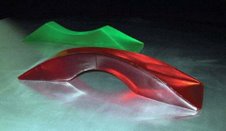Jello gains some backbone
In my continuing quest to bring you the best and worst of the jello molds, here’s an effort that’s an example of the former—an esthetic vision of some loveliness, and a demonstration of the surprising strength of properly reinforced jello:


With enough jello and reinforcement, your could reconstruct the animal it came from.
Ain’t language great? “My interest was in letting the jello do something unexpected.” How elevated (and animistic) is that compared to “I wanted to make some jello that was different from usual jello.”
Gels really behave strange from continuum mechanics perspective: a middle ground between elasticity theory and fluid dynamics. Mathematically, the relevant equations are the most complex and challenging in the whole realm of mechanics, and no consistent theory exists. The arc bridges on the picture are not really reinforced, except for their form: large bearing faces on the flat bottom surface keep the arcs in compression, to which type of loading gels are stable.
Surprised at the strength of Jello? Hah! I have two words for you: Gummi Bears.
As in
How to Make Gummy Bears – wikiHow
The Ultimate Jello Shot awaits your attention:
The Experiment
The purpose of this experiment was to determine the highest possible concentration of alcohol attainable in a Jell-O shot, while still maintaining the structural integrity (i.e., the gelling properties) of the gelatin.
Sergey, on the topic of fluid dynamics: I’ve always been fascinated by the behavior of corn starch. If you get the right mixture of water and starch, to something like a thick gel consistency, when you push against the starch, it hardens, resists. Take away the spoon, it flows freely. I’ve always thought there must be some use for such a “fluid” in hydraulic applications, but have never heard of any. Do you know of any?
Well, I googled cornstarch and discovered lots of other people also like to play with it–but no practical applications founds as yet.
This is called thixotropy and widely used in mud solutions for drilling and tunneling. This is not the same as gels, but you could observe some strange effects of such liquids, too. If on a beach you step on the wet sand, it will not yield under pressure, but just opposite: form a salience under your foot. Such liquids expand, not shrink, under pressure, and so prevent jamming of the drilling tool.
Another hydraulic application of suspensions of particles in a fluid is hydraulic electromagnetic quick-release coupling: magnetic particles are suspended in hydraulic liquid in a vessel placed inside a solenoid. When no current applied to solenoid, the suspension behaves like liquid, but if current is switched on, it behaves as solid transmitting angular momentum.
Sergey: Thanks. I’m on my way to look up mud solutions in drilling.
The most important use of gels is in bacteriology, as substrate to grow bacterial colonies, and immunology, to observe reaction of anti-bodies with antigenes. In biochemistry gels are used to fractionate proteins in gel chromatography. But instead of gelatin they use agar-agar, a substance extracted from sea weeds, or polyacrylimide gels. I played a lot with such gels when working in biological laboratories.
Neo, should any of us be concerned with your jello-phile tendencies? This obsession is starting to get disturbing, though, funny as hell!! 😉
I like this one!